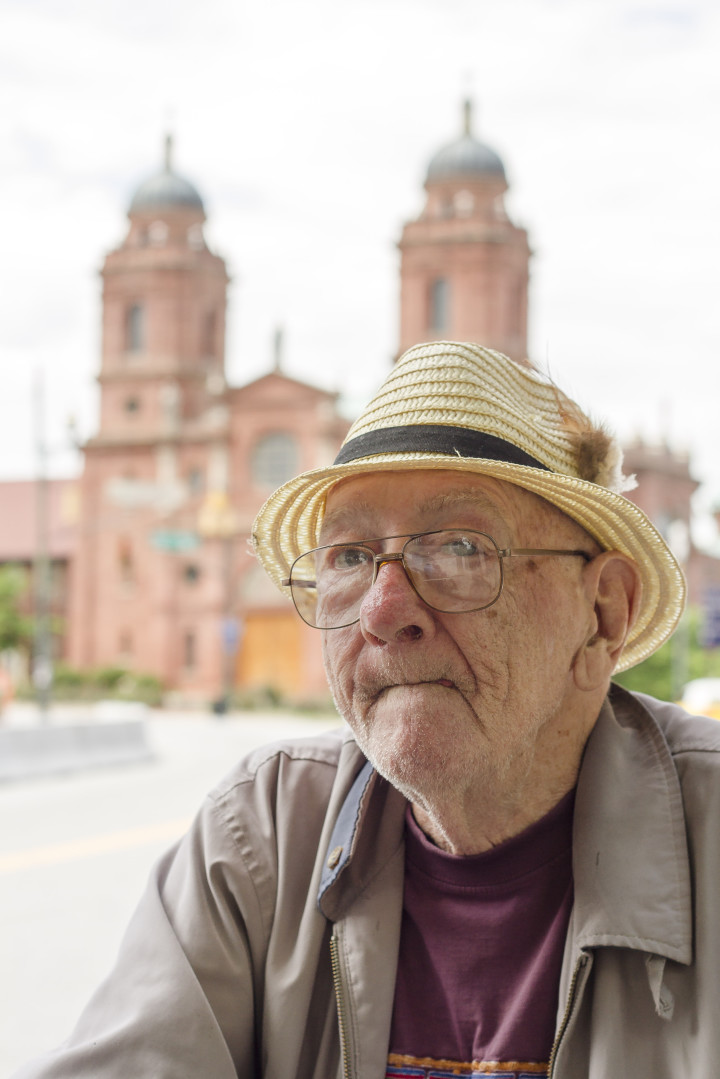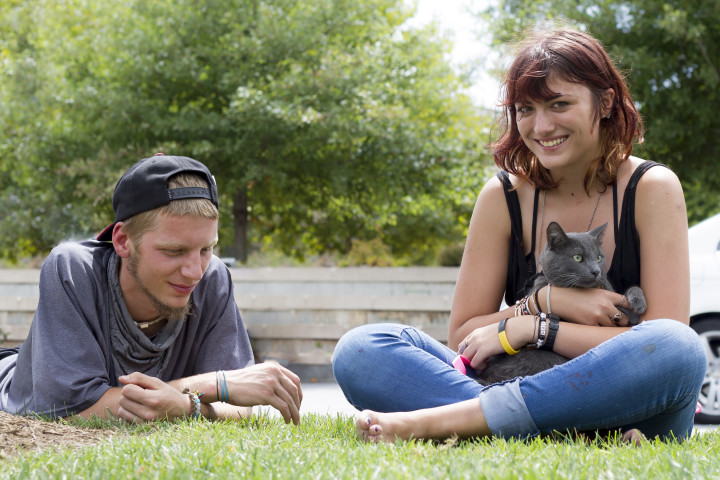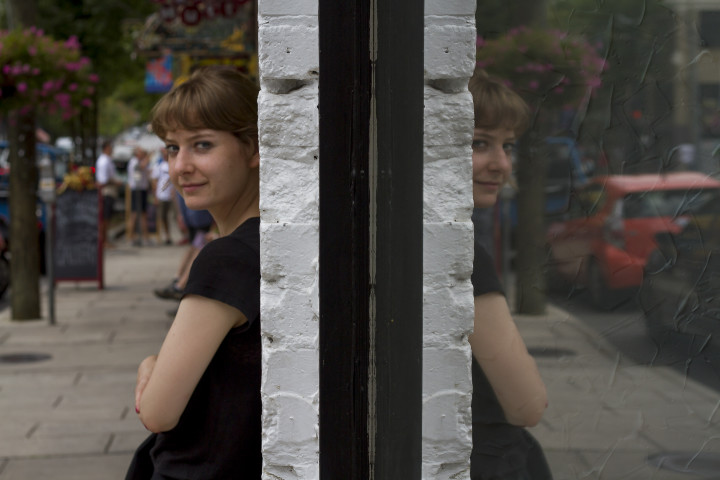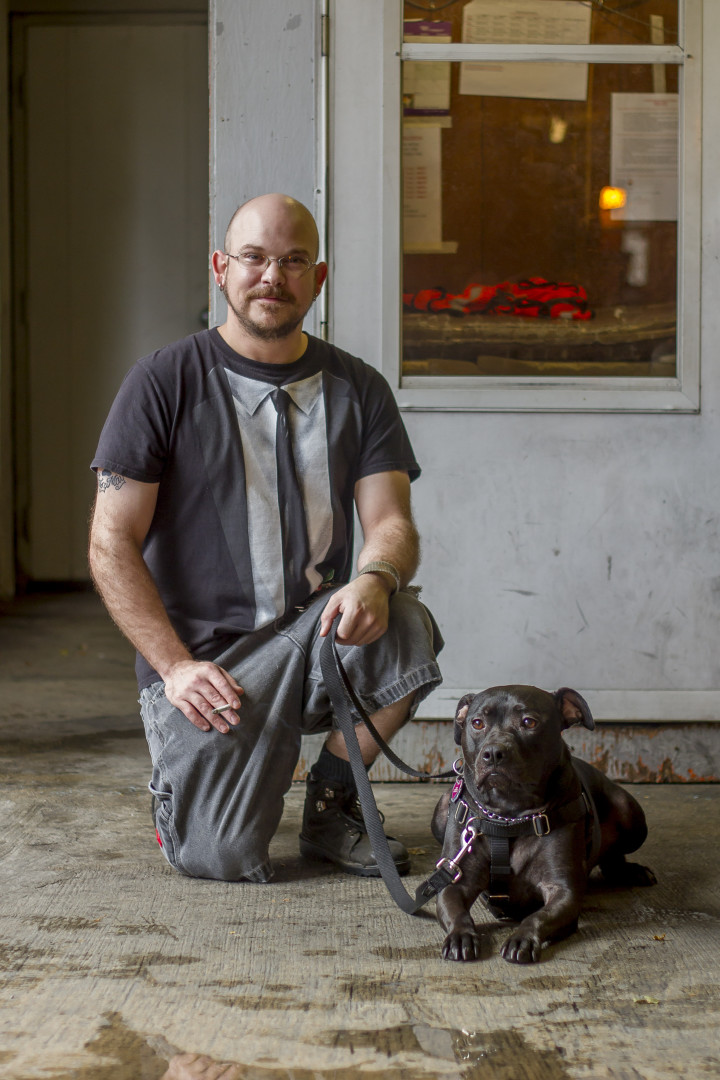
Then she said, ‘Well, what would you do if I died?’ I told her, ‘I would send my siblings a sympathy card and still go to Kentucky.’
That was the best day of my life.”
It’s a sunny day when Jennifer Mesk, the photojournalist behind Humans of Asheville, sets out across the city that serves as her muse. Spotting a group of interesting-looking characters on Patton Avenue, she motions to them, then indicates her camera. They smile curiously, and she crosses the street. “Hi,” she says, smiling. “Can I take your picture?”
That’s how the conversation starts. If they agree, she presses deeper. “What’s your greatest accomplishment in life so far?” If they choose to answer, Mesk snaps the photo and quickly pulls out her iPhone to record her short conversation with a stranger on the street.
Every picture tells a story
The local photographer didn’t originate the snapshot-into-the-lives-of-strangers idea. In fact, the format, replicated in a number of cities, takes it cues from Humans of New York, or HONY, to its legions of followers. In 2010, photographer and blogger Brandon Stanton set out to snap photos of 10,000 New Yorkers and plot their images on a map of the city. Somewhere along the way, he began grabbing quotes and anecdotes from his subjects and posting them with the pictures.
Four years later, Stanton has amassed nearly 10 million followers, a New York Times best-selling book based on his blog, and countless copycat “Humans of” accounts have cropped up around the globe. “I think the primary reason for the popularity of this series stems from a fundamental human need for connectedness,” says Elizabeth Pascoe, assistant professor of psychology at UNC Asheville. “It is thought that we may have evolved to desire connection with other human beings, as this connectedness urges us to form groups, and living in groups may have increased our chances of survival. Nowadays, this connection may continue to aid us in feeling as if we belong, that we fit, that we are accepted by and acceptable to others, increasing our self-esteem and enhancing our relationships.” To choose one reason out of many, she says, “HONY may allow us to feed that need through the process of self-disclosure.”
Often the stories that Mesk’s subjects share are more than captions — they inform the photographer’s approach to the portrait. “A lot of times I take the initial photo, then start talking to them and realize I need to take a completely different kind of photo,” she says. “There was this guy I spoke with. We started talking … and I asked him what makes him happy.”

“That’s how I met him. I run around in angel wings.”
The man said his fiancee makes him happy and proceeded to tell Mesk the story of how they met. “He pulled up her picture on his iPad, and I said, ‘She has to be in the photo!’” Mesk then reshot the picture, this time with the fiancee and their story included. “I like the challenge of having to get a picture of somebody in a short period of time and get it right,” she says.
“Psychological research has shown that disclosing personal or intimate information about one’s self facilitates bonding,” says Pascoe, who specializes in social psychology. “The secret-teller (or storyteller) is expressing their feelings, opinions, thoughts, innermost desires. In receiving this information, the witness may discover similarities between herself and the secret-teller … and that others have experienced difficulty; that we don’t all have it together. That sometimes what we want in life is something much more simple than what we assume society expects from us.”
Meet and greet
Mesk, who began her Humans of Asheville Facebook page in late December, didn’t initially intend to collect stories. She was interested in snapping sneaky photos of people at music festivals. Mesk had never considered herself a professional photographer — she took photos only as a favor to friends and for her own enjoyment. But after seeing her portraits, one friend suggested that she make a “Humans of” page. Initially, Mesk was hesitant to put herself out there: “I was used to taking sly photos of people and not necessarily speaking to them. So for the first couple of weeks, I was like, ‘Oh my gosh, I have to go up to these people!’
“And I have no problem talking to people, but approaching people I’ve never met?” she continues. “I’ve missed some really cool shots because I’ve chickened out. So I’ve used that as an inspiration or motivation — to just go in and if they say no, it’s no big deal. At least I tried.”

In fact, says Mesk, in the 10 months she’s been at this, she’s been turned down only three or four times. “That’s fine — I’m not going to force somebody. But the most awkward encounter that I’ve had, there was this guy who sits near the library and smokes cigarettes. And he just looked so interesting. I thought, one of these days I’m going to get his picture. So I went over, plopped down next to him, told him what I was doing and said, ‘May I take your picture?’”
The man grunted a “yes” and half-nodded. “I take the photo and start asking him questions, and he’s doing this,” Mesk says, as she mimes smoking a cigarette, bobbing her head and staring off down the street. “I’m like, ‘All right, sir: You have a great day!’ Oh my gosh, I felt so awkward. I realized it was time to give this person his space.”
Compared with other cities, Asheville has its own set of challenges. While visiting Portland, Ore., earlier this year, Mesk surprised her husband with a renewal of their vows, caught on camera by Briana Cerezo, the photographer behind Humans of Portland, another HONY copycat blog. “I thought it would be perfect,” says Mesk. “Humans to humans. It was nice to meet somebody doing the same thing and share the different experiences that we’ve had.”
The two photographers talked about the need to keep the task lighthearted and fun. Turning a project like “Humans of” into a job can and will show up in your work, Cerezo said. She advised Mesk just to have fun and tune out the negativity that can come from putting yourself out there. “She said she was starting to feel like she had to go out and take pictures, but she realized that to keep it fresh, it should not be forced,” Mesk explains.
Of course, Mesk told the Portland photographer as they shared on-the-ground experiences, “You’ve got a lot more ground to cover. I can do a lap around [Asheville’s] downtown in an hour.”
She adds, “That’s what’s cool about the size of Asheville,” though that intimate scale brings its own problems. “I’ve already realized there are three pictures on my page of the same two girls,” continues Mesk, saying she didn’t even realize it “until I got home and I’m editing the photo, wondering, ‘Why do they look so familiar?’ … It was bound to happen someday.”
Instagram nation

But Asheville’s cozy confines can also generate a neighborly feeling. And though Mesk isn’t seeking notoriety or to make this her job (she’s busy home-schooling her high-school-aged son), she says she takes photos for the simple pleasure of meeting and connecting with new people.
“We have a need to relate to other people. We don’t get that need very well met in a society where communications are all by cellphones and we’re connected to each other by Instagram,” says Kathryn Liss, an instructor of behavioral and social science and sociology at A-B Tech. “We’re so addicted to all of these forms of watching other people’s lives instead of living our own. It in some way has to relate to the fact that we’re not connected to our own lives, and we have a need for that.”
The Humans of Asheville Facebook page has generated interest, with more than 4,500 followers and top posts garnering around 300 likes. “It’s nice to feel like you’re a part of the community,” the photographer says, adding that she’s made lots of friends through the project. “Because now I come downtown and I’m like, ‘Hey, what’s up?’”
Plus, the Humans of Asheville page is gaining fans from beyond Western North Carolina: “Someone wrote [on her page] that they’re moving here and said, ‘I can’t wait to be a Human of Asheville!’”
That kind of reach is a product of these projects’ format. “I think HONY, in telling simple stories from many different people, goes beyond this one-on-one connection, allowing the bonding to happen on a bigger plane,” says Pascoe. “Instead of bonding with a specific human being, as a result of that person’s disclosure, we see many personal stories. Hence we may come to realize that, as a species, human beings are more alike in their desires, wishes and expectations than we typically assume, and this makes us feel good.”
And as her own project now casts a wider net, with followers popping up all over the country and even the world, Mesk agrees, noting that each HONY copycat, when done right, has universal appeal. “Humans of, Portraits of, Souls of San Francisco. I follow pages in Ireland, Germany, Spain — they’re great,” Mesk says. She even cites a “Humans of” page from Nelson, British Columbia, as one of her very favorites, though the town’s population is just over 10,000. Humans of New York may be the blog that started it all, but it doesn’t take a large population to make a big impact.
To view Humans of Asheville, visit avl.mx/0gh. To become a potential Human of Asheville, all you have to do is stroll around downtown — through Pritchard Park, outside the library — or try gazing pensively out at the street through the open window of a restaurant, brewery or bar. You just might run into the woman behind the camera.




Didn’t Jenny Bowen do something like this a few years ago?
This is a great project, but hopefully Jennifer doesn’t forget that Asheville is a lot more than just downtown. Looking through the article, and the last few months on the page, it’s extremely heavy on the hipper, younger side of this town and visitors to our fair city. Feels like some excursions to areas where tourists and young creatives are less likely to be found would give a much fuller picture of the diversity of people and perspectives and life stories in town.
Nate makes a good point. Could the photographer hang out some all along Merrimon Ave, around the Beaver Lake Bird Sanctuary, with the walkers and runners along Beaver Lake, with the folks at Atlanta Bread, Edna’s, Ave M, Ace Hardware, CVS, et al., etc. Maybe the folks in East Asheville, West Asheville, South Asheville will have suggestions for her as well. Dare I say she needs to go where the “real humans of Asheville” live, work, and play?